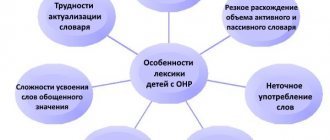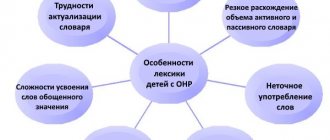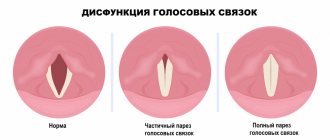Phonation disorders of oral speech in children and adults
Aphonia (dysphonia) is the absence of voice, or a violation of its strength, pitch or timbre.
It occurs due to organic or functional defects of the voice-forming mechanism. Impaired speech rate:
- – pathologically slow rate of speech, slow articulation. The result of a violation of the speech centers in the cerebral cortex. In origin, this speech disorder can be organic or functional. Speech sounds drawn out, drawn out, sluggish and monotonous;
- – pathologically fast rate of speech, accelerated articulation. Speech is hasty, rapid, assertive, accompanied by agrammatisms.
Stuttering is a disturbance in the tempo, rhythm and fluency of speech due to the convulsive state of the muscles of the speech apparatus. Most often it occurs as a sharp negative reaction to an external stimulus.
Dyslalia is a violation of the pronunciation of sounds with normal hearing and development of the speech apparatus. Distorted pronunciation of sounds, replacement of sounds or their confusion. This may occur due to anatomical defects of the articulatory apparatus or due to unfavorable conditions for speech development and phonemic hearing disorders.
Rhinolalia (nasality) is a violation of voice timbre and sound pronunciation due to anatomical and physiological defects of the speech apparatus. Symptoms of this speech disorder: monotonous and unintelligible speech, nasal tone, nasal tone of speech.
Dysarthria (tongue-tied) is a pronunciation disorder due to the immaturity of all parts of the sound pronunciation mechanism. The cause of this speech disorder is the result of damage to the central nervous system.
Types of speech disorders article (speech therapy) on the topic
Types of speech disorders.
Currently, speech therapy uses two classifications of speech disorders: clinical-pedagogical and psychological-pedagogical. These classifications do not contradict each other, but complement each other, considering the same problems from different points of view.
The clinical and pedagogical classification of speech disorders is based on the traditional collaboration between speech therapy and medicine; it is focused on the correction of speech defects, and therefore is based on an approach from the general to the specific.
The main types of speech disorders considered in this classification are divided into two groups.
Oral speech disorders.
I. Disorders of phonation of utterances.
Dyslalia is a violation of sound pronunciation with normal hearing and intact innervation of the speech apparatus.
Depending on the preservation of the anatomical structure of the speech apparatus, two types of dyslalia are distinguished:
• functional;
• mechanical.
Functional dyslalia occurs in childhood during the process of mastering the pronunciation system, mechanical dyslalia occurs at any age due to damage to the peripheral speech apparatus. In some cases, combined functional and mechanical defects occur.
Causes of functional dyslalia:
- general physical weakness caused by frequent somatic diseases that occur during the period of the most intensive formation of speech function;
- insufficient degree of development of phonemic hearing;
- unfavorable speech conditions in which the child is raised;
- bilingualism in the family.
Causes of mechanical dyslalia:
- defects in the structure of the maxillodental system (defects in the structure of the dentition, defects in the structure of the jaws, shortened or too massive frenulum of the tongue);
- pathological changes in the size and shape of the tongue;
- irregular structure of the hard and soft palate;
- atypical lip structure.
Violations of sound pronunciation in the speech of a child with dyslalia can manifest themselves:
-lack of sound: ampa (lamp), aketa (rocket);
-the sound is pronounced distorted, i.e. is replaced by a sound that is absent in the phonetic system of the Russian language: for example, instead of r it is pronounced “throat”; instead of c - interdental c;
-the sound is replaced by a sound that is simpler in articulation (l → y).
Dysphonia (aphonia) is the absence or disorder of phonation due to pathological changes in the vocal apparatus.
It manifests itself either in the absence of phonation (aphonia), or in a violation of the strength, pitch and timbre of the voice (dysphonia), can be caused by organic or functional disorders of the voice-forming mechanism of central or peripheral localization and occur at any stage of the child’s development. It can be isolated or part of a number of other speech disorders.
Bradylalia is a pathologically slow rate of speech.
It manifests itself in the slow implementation of the articulatory speech program, is centrally conditioned, and can be organic or functional. At a slower pace, speech turns out to be drawn out, sluggish and monotonous.
Tahilalia is a pathologically accelerated rate of speech.
It manifests itself in the accelerated implementation of the articulatory speech program, is centrally conditioned, and can be organic or functional. At an accelerated pace, speech is pathologically hasty, rapid, and assertive.
Bradylalia and tachylalia are combined under the common name - impaired speech tempo. The consequence of an impaired speech rate is a violation of the smoothness of the speech process, rhythm and melodic-intonation expressiveness.
Stuttering is a violation of the tempo-rhythmic organization of speech, caused by the convulsive state of the muscles of the speech apparatus. It is centrally determined, has an organic or functional nature, and occurs most often during the child’s speech development.
The symptoms of stuttering are characterized by physiological and psychological symptoms.
Physiological symptoms:
-convulsions, which are classified by form and location;
- violation of the melodic-intonation side of speech;
- the presence of involuntary movements of the body and face;
- violation of speech and general motor skills.
Psychological symptoms:
- the presence of logophobia (fear of speech in certain situations, fear of pronouncing individual words, sounds);
-the presence of protective techniques (tricks) - speech (pronouncing individual sounds, interjections, words, phrases) and motor, changing the style of speech;
- varying degrees of fixation on stuttering (zero, moderate, pronounced).
There are different degrees of severity of stuttering: mild (stuttering appears only in an excited state, when trying to quickly speak out), moderate (in a calm state, in a familiar environment, stuttering does not appear, in an emotionally excited state, severe stuttering appears), severe (stuttering appears constantly) .
Rhinolalia is a violation of voice timbre and sound pronunciation, caused by anatomical and physiological defects of the speech apparatus.
Rhinolalia manifests itself in a pathological change in the timbre of the voice, which turns out to be excessively nasalized due to the fact that the vocal-exhalatory stream passes when pronouncing all speech sounds into the nasal cavity and receives resonance in it. Speech with rhinolalia is slurred and monotonous.
Rhinolalia closed is a disorder of sound pronunciation, which is expressed in a change in the timbre of the voice; the cause is organic changes in the nasal or nasopharyngeal region or functional disorders of the nasopharyngeal seal.
Open rhinolalia is a pathological change in voice timbre and distorted pronunciation of speech sounds, which occurs when the soft palate lags far behind the back wall of the pharynx when pronouncing speech sounds.
Rhinolalia mixed.
Dysarthria is a violation of the pronunciation aspect of speech caused by insufficient innervation of the speech apparatus.
The leading defect in dysarthria is a violation of the sound pronunciation and prosodic aspects of speech associated with organic damage to the central and peripheral nervous systems.
Sound pronunciation disturbances in dysarthria manifest themselves to varying degrees and depend on the nature and severity of damage to the nervous system. In mild cases, there are individual distortions of sounds, “blurred speech”; in more severe cases, distortions, substitutions and omissions of sounds are observed, tempo, expressiveness, modulation suffer, and in general the pronunciation becomes slurred. With severe damage to the central nervous system, speech becomes impossible due to complete paralysis of the speech motor muscles. Such disorders are called anarthria. Based on the localization of damage to the motor apparatus of speech, the following forms of dysarthria are distinguished: bulbar, pseudobulbar, extrapyramidal (or subcortical), cerebellar, cortical.
There are four degrees of severity of speech disorders in such children.
The first is the mildest degree, when sound pronunciation disorders are detected only by a specialist during the examination of the child.
The second is that pronunciation violations are noticeable to everyone, but speech is understandable to others.
Third, the speech is understandable only to the child’s loved ones and partially to those around him.
The fourth is the most severe, absence of speech or speech is almost incomprehensible even to the child’s loved ones (anarthria). Anarthria refers to the complete or partial absence of the ability to produce sounds as a result of paralysis of the speech motor muscles.
Anarthria can vary in severity:
- severe complete absence of speech and voice;
— moderate presence of only vocal reactions;
- slight presence of sound-syllable activity.
II. Violations of the structural and semantic design of statements.
Alalia is the absence or underdevelopment of speech in children with normal hearing and primarily intact intelligence.
The cause of alalia is damage to the speech areas of the cerebral hemispheres during childbirth, as well as brain diseases or injuries suffered by the child in the pre-speech period of life.
Motor alalia develops when the functions of the fronto-parietal areas of the cortex of the left hemisphere of the brain (Broca's center) are impaired and manifests itself in a violation of expressive speech with a fairly good understanding of addressed speech, late formation of phrasal speech (after 4 years) and poverty of pre-speech stages (frequent absence of babbling) . Accompanied by a gross violation of grammatical structure. There is a pronounced poverty of vocabulary. In the mental state of children with a similar disorder, there are often manifestations of varying degrees of severity of psychoorganic syndrome in the form of motor disinhibition, attention and performance disorders in combination with intellectual development disorders.
Sensory alalia occurs with damage to the temporal region of the left hemisphere (Wernicke's center) and is associated with disturbances in the acoustic-gnostic aspect of speech while hearing is intact. It manifests itself in insufficient understanding of addressed speech and a gross violation of its phonetic side with a lack of differentiation of sounds. Children do not understand the speech of others, due to which expressive speech is extremely limited, they distort words, mix sounds that are similar in pronunciation, do not listen to the speech of others, may not respond to a call, but at the same time react to abstract noises, are noted; auditory attention is sharply impaired, although the timbre of speech and intonation are not changed. In the mental state, there are signs of organic brain damage - often in combination with intellectual underdevelopment in a wide range (from mild partial developmental delays to mental retardation).
Aphasia is a complete or partial loss of speech caused by local lesions of the brain.
A child loses speech as a result of traumatic brain injury, neuroinfection, or brain tumors after speech has been formed.
There are six forms of aphasia: acoustic-gnostic and acoustic-mnestic aphasia, arising from damage to the temporal parts of the cerebral cortex, semantic aphasia and afferent motor aphasia, arising from damage to the lower parietal parts of the cerebral cortex, efferent motor aphasia and dynamic aphasia, arising from damage premotor and posterior frontal parts of the cerebral cortex (on the left in right-handed people).
Impaired writing.
Dyslexia is a partial specific disorder of the reading process.
Manifests itself in difficulties in identifying and recognizing letters; in difficulties merging letters into syllables and syllables into words, which leads to incorrect reproduction of the sound form of the word; in agrammatism and distorted reading comprehension.
Phonemic dyslexia is caused by a disorder in the development of phonemic awareness and phonemic analysis and synthesis. It manifests itself in the replacement of phonetically similar sounds when reading, in difficulties in mastering letters denoting acoustically and articulatory similar sounds, possibly also letter-by-letter reading, and distortion of the sound-syllable structure of a word.
Agrammatic dyslexia manifests itself in agrammatism when reading. During the reading process, the child incorrectly pronounces endings, prefixes, and suffixes, changing the grammatical forms of words.
Semantic dyslexia manifests itself as a violation of reading comprehension during technically correct reading. Semantic dyslexia can manifest itself both at the word level and when reading sentences and text.
Optical dyslexia manifests itself in substitutions and mixtures of graphically similar letters when reading. With this type of dyslexia, mirror reading can also be observed.
Mnestic dyslexia manifests itself in a violation of the acquisition of letters, in difficulties in establishing associations between sounds and letters. The child does not remember which letter corresponds to which sound.
Dysgraphia is a partial specific disorder of the writing process.
It manifests itself in the instability of the optical-spatial image of the letter, in confusion or omission of letters, in distortions of the sound-syllable composition of the word and the structure of sentences.
Articulatory-acoustic dysgraphia manifests itself in mixtures, substitutions, and omissions of letters, which correspond to mixtures, substitutions, and absence of sounds in oral speech.
Acoustic dysgraphia manifests itself in substitutions of letters denoting phonetically similar sounds, in violation of the designation of soft consonants in writing.
Dysgraphia due to a violation of language analysis and synthesis manifests itself in the continuous spelling of words, especially prepositions; in the separate spelling of words, especially prefixes and roots.
Agrammatic dysgraphia manifests itself in agrammatisms in writing and is caused by the immaturity of the lexico-grammatical structure of speech. Agrammatisms are noted at the level of words, phrases, sentences and text.
Optical dysgraphia In optical dysgraphia, the following types of writing disorders are observed: distorted reproduction of letters in writing, replacement and mixing of graphically similar letters. One of the manifestations of optical dysgraphia is mirror writing: mirror writing of letters, writing from left to right, which can be observed in left-handed people, with organic damage brain
Psychological and pedagogical classification:
This classification takes into account the structural components of the speech system (sound aspect, grammatical structure, vocabulary), functional aspects of speech, and the ratio of types of speech activity (oral and written).
Speech disorders in the psychological and pedagogical classification are divided into two groups.
The first group is a violation of means of communication.
It distinguishes:
Phonetic-phonemic underdevelopment (PPI) is a violation of the processes of formation of the pronunciation system of the native language in children with various speech disorders due to defects in the perception and pronunciation of phonemes.
The main manifestations characterizing this condition:
- undifferentiated pronunciation of pairs or groups of sounds. In these cases, the same sound can serve as a substitute for two or even three other sounds for the child. For example, the soft sound t' is pronounced instead of the sounds s', ch, sh (“tyumka”, “tyaska”, “chopper” instead of bag, cup, hat);
-replacement of some sounds with others that have simpler articulation and present less pronunciation difficulty for the child. Usually, sounds that are difficult to pronounce are replaced by easier ones, which are characteristic of the early period of speech development. For example, the sound l is used instead of the sound r, the sound f - instead of the sound w;
-mixing sounds. This phenomenon is characterized by the unstable use of a number of sounds in different words. A child can use sounds correctly in some words, but in others, replace them with similar ones in articulation or acoustic characteristics. So, a child, being able to pronounce the sounds r, l or s in isolation, in speech utterances says, for example, “Stolyal is laying a plank” instead of a carpenter planing a board.
General speech underdevelopment (GSD) is a variety of complex speech disorders in which the formation of all components of the speech system is impaired, i.e. the sound side (phonetics) and the semantic side (vocabulary, grammar).
General underdevelopment of speech can be observed in complex forms of childhood speech pathology: alalia, aphasia (always), as well as rhinolalia, dysarthria.
Despite the different nature of the defects, the following general patterns can be identified in children with ODD:
-much later appearance of speech;
-limited vocabulary;
- gross violations of grammatical structure;
- pronounced deficiencies in sound pronunciation;
-the speech of children with ODD is difficult to understand.
There are three levels of OHP.
The first level of speech development is characterized by the absence of speech (the so-called “speechless children”). Such children use “babble” words, onomatopoeia, and accompany “statements” with facial expressions and gestures. The child reproduces commonly used words in the form of individual syllables and combinations.
Second level of speech development. In addition to gestures and “babbling” words, although distorted, but fairly constant commonly used words appear, in independent statements simple common sentences of 2-3-4 words appear. Children in this category have a limited passive vocabulary, agrammatisms (incorrect use of grammatical structures), omission of prepositions, and lack of agreement between adjectives and nouns. Children's pronunciation abilities lag significantly behind the age norm. The syllable structure is broken.
The third level of speech development is characterized by the presence of extensive phrasal speech with elements of lexico-grammatical and phonetic-phonemic underdevelopment. Free communication is difficult. Despite significant progress in the formation of independent speech, the main gaps in the lexico-grammatical and phonetic design of coherent speech are clearly identified.
The second group is violations in the use of means of communication.
This group includes stuttering, which is considered as a violation of the communicative function of speech with correctly formed means of communication. A combined defect is also possible, in which stuttering is combined with general speech underdevelopment (GSD).
Literature:
1. Zhukova N.S., Mastyukova E.M., Filicheva T.B. Speech therapy. Ekaterinburg, "ARD LTD", 1998.
2. Speech therapy / Ed. L.S. Volkova M., “Vlados”, 1998.
Prepared by teacher-speech therapist OBUSO “Malovishersky
social shelter for children" Alekseeva Elena Vasilievna
Structural and semantic disorders of oral speech
Alalia - or underdeveloped speech due to organic damage to the speech areas of the cerebral cortex in the womb or in infancy. A system of phonemic, grammatical and lexical language means is not formed. Impaired control of speech movements, which affects the reproduction of sounds and syllables. This speech disorder is more difficult to correct than others.
Aphasia is a complete or partial loss of previously formed speech skills due to vascular disorders, inflammatory processes in the brain or traumatic brain injury. Usually aphasia is called a disorder if it occurs after three years.
Another classification according to which types of speech disorders are divided:
- Impaired communication:
- phonetic-phonemic underdevelopment of speech - a violation of the formation of pronunciation in patients with any speech disorders;
- general underdevelopment of speech is a violation of the formation of all components of speech, both sound and semantic. Signs of general speech impairment: late development of speech, poor vocabulary, pronunciation defects, agrammatisms. The degree of impairment can vary from dyslalia to complete absence of speech (alalia).
- Violations in the use of means of communication - when the means of communication are formed correctly, but the communicative function of speech is impaired. This includes, for example, stuttering.
Dislalia
The most common speech therapy problem for children aged 4-5 years and older. This term refers to the incorrect pronunciation of sounds, sometimes two or three sounds, and sometimes half the alphabet. You can confidently make such a conclusion about dyslalia if:
- the child’s vocabulary of passive and active vocabulary corresponds to age;
- he constructs phrases and sentences correctly;
- words are consistent in gender, number and case.
If, in addition to defective pronunciation of sounds, there are other violations, then we can talk about a general underdevelopment of speech.
Classification of writing disorders
Disorders of the development of written speech in children are divided into two groups. It depends on what type of it is impaired - the very possibility of writing (productive) or reading (receptive).
Dyslexia is a reading disorder that is associated with damage or underdevelopment of certain areas of the cerebral cortex. There is difficulty recognizing letters when they are merged into syllables and recognizing syllables when they are merged into words. All this leads to very slow reading, incorrect reproduction of words, as well as incorrect understanding of even simple texts. Severe dyslexia is a complete inability to master reading skills, an absolute failure to recognize letters and words, even if they are clearly visible.
Dysgraphia is a partial specific disorder of the writing process. It manifests itself in unstable images of letters, distortion of the sound and syllabic composition of the word, as well as the structure of the sentence. Dysgraphia occurs against the background of underdeveloped oral speech. Agraphia, the most severe degree of dysgraphia, is the inability to combine letters and syllables into words, missing letters and syllables, twisting words, and even a complete loss of the ability to write.
Clinical and pedagogical classification
Goal: clear and detailed description of the types of disorders, taking into account the interstructural interaction of speech defects with their underlying causes, including those of a natal and prenatal nature. It is based on a number of psychological, linguistic, medical, clinical and etiopathogenetic factors that have a complex impact. All types of speech impairments are divided into 2 groups: disorders of oral and written speech (clickable diagram).
A significantly different view on the systematization of childhood deviations was proposed by R. E. Levina. Her works laid the foundation for children's speech therapy, which subsequently became a separate area with its own object of study.
General speech underdevelopment
This is a complex of various speech pathologies, expressed by the following characteristic features:
- undeveloped coherent speech;
- violation of pronunciation and differentiation of sounds;
- vocabulary is poor and not age appropriate;
- word formation and inflection are difficult.
With general underdevelopment of speech, all components of the system suffer: phonetics, vocabulary, grammar. Such children start speaking late. They understand the speech of others, but cannot formulate the statement themselves.
There are three levels of OHP:
- There are individual elements of speech, babbling words, one-word sentences, abbreviations of complex words.
- Speech consists of short phrases consisting of 2-3 distorted words, with syllables rearranged and inconsistent with each other.
- The use of prepositions, endings, and the syllabic structure of complex words is impaired.
The main causes of such speech therapy problems in children are the pathological course of pregnancy and birth trauma. They can also be the causes of the following speech pathology.






